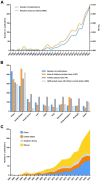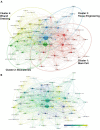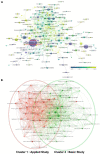Deciphering the focuses and trends in skin regeneration research through bibliometric analyses
- PMID: 35935762
- PMCID: PMC9355679
- DOI: 10.3389/fmed.2022.947649
Deciphering the focuses and trends in skin regeneration research through bibliometric analyses
Abstract
Increasing attention to skin regeneration has rapidly broadened research on the topic. However, no bibliometric analysis of the field's research trends has yet been conducted. In response to this research gap, this study analyzed the publication patterns and progress of skin regeneration research worldwide using a bibliometric analysis of 1,471 papers comprising 1,227 (83.4%) original articles and 244 (16.6%) reviews sourced from a Web of Science search. Publication distribution was analyzed by country/region, institution, journal, and author. The frequency of keywords was assessed to prepare a bibliometric map of the development trends in skin regeneration research. China and the United States were the most productive countries in the field: China had the greatest number of publications at 433 (29.4%) and the United States had the highest H-index ranking (59 with 15,373 citations or 31.9%). Author keywords were classified into four clusters: stem cell, biomaterial, tissue engineering, and wound dressing. "Stem cells," "chitosan," "tissue engineering," and "wound dressings" were the most frequent keywords in each cluster; therefore, they reflected the field's current focus areas. "Immunomodulation," "aloe vera," "extracellular vesicles," "injectable hydrogel," and "three-dimensional (3D) bioprinting" were relatively new keywords, indicating that biomaterials for skin regeneration and 3D bioprinting are promising research hotspots in the field. Moreover, clinical studies on new dressings and techniques to accelerate skin regeneration deserve more attention. By uncovering current and future research hotspots, this analysis offers insights that may be useful for both new and experienced scholars striving to expand research and innovation in the field of skin regeneration.
Keywords: 3D bioprinting; bibliometric analysis; skin regeneration research; tissue engineering; wound dressing.
Copyright © 2022 Zhou, Dong, Shu, Chen, Wang, Wang and Ma.
Conflict of interest statement
The authors declare that the research was conducted in the absence of any commercial or financial relationships that could be construed as a potential conflict of interest.
Figures







Similar articles
-
Global Research Status and Trends in Hair Follicle Stem Cells: a Bibliometric Analysis.Stem Cell Rev Rep. 2022 Aug;18(6):2002-2015. doi: 10.1007/s12015-022-10404-1. Epub 2022 Jul 8. Stem Cell Rev Rep. 2022. PMID: 35802225
-
Focuses and Trends of Research on Platelet-Rich Fibrin: A Bibliometric and Visual Analysis.Indian J Plast Surg. 2024 Sep 11;57(5):356-363. doi: 10.1055/s-0044-1779478. eCollection 2024 Oct. Indian J Plast Surg. 2024. PMID: 39552803 Free PMC article.
-
A bibliometric analysis of hotpots and trends for the relationship between skin inflammation and regeneration.Front Surg. 2023 Apr 21;10:1180624. doi: 10.3389/fsurg.2023.1180624. eCollection 2023. Front Surg. 2023. PMID: 37151861 Free PMC article.
-
Bibliometric and visualized analysis of 3D printing bioink in bone tissue engineering.Front Bioeng Biotechnol. 2023 Jul 20;11:1232427. doi: 10.3389/fbioe.2023.1232427. eCollection 2023. Front Bioeng Biotechnol. 2023. PMID: 37545887 Free PMC article.
-
Bioprinted hydrogels in bone regeneration: a bibliometric analysis.Front Pharmacol. 2025 Feb 3;16:1532629. doi: 10.3389/fphar.2025.1532629. eCollection 2025. Front Pharmacol. 2025. PMID: 39963238 Free PMC article. Review.
Cited by
-
[Thinking and prospect of scar reconstruction].Zhonghua Shao Shang Yu Chuang Mian Xiu Fu Za Zhi. 2023 Sep 20;39(9):801-805. doi: 10.3760/cma.j.cn501225-20230504-00153. Zhonghua Shao Shang Yu Chuang Mian Xiu Fu Za Zhi. 2023. PMID: 37805794 Free PMC article. Chinese.
-
Advancements in engineered exosomes for wound repair: current research and future perspectives.Front Bioeng Biotechnol. 2023 Nov 14;11:1301362. doi: 10.3389/fbioe.2023.1301362. eCollection 2023. Front Bioeng Biotechnol. 2023. PMID: 38033824 Free PMC article. Review.
-
Enhanced skin regeneration and therapeutic delivery using novel diamond-augmented zinc oxide.J Cosmet Dermatol. 2024 Dec;23(12):4043-4050. doi: 10.1111/jocd.16508. Epub 2024 Jul 31. J Cosmet Dermatol. 2024. PMID: 39083431 Free PMC article.
References
-
- Park U, Kim K. Multiple growth factor delivery for skin tissue engineering applications. Biotechnol Bioprocess Eng. (2017) 22:659–70. 10.1007/s12257-017-0436-1 - DOI
LinkOut - more resources
Full Text Sources
Miscellaneous

